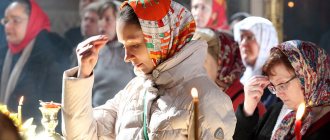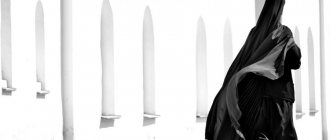Differences in the application of the sign of the cross by different religions/
Religion - each person puts his own meaning into this word and understands it differently. Today there are a huge number of religions that are similar or different from each other.
The most widespread and professed are perhaps Christianity, Judaism and Islam. Despite the fact that in the age of information technology, every person has access to almost any information, many people do not know what the essence of each religion is, what they have in common and how they actually differ from each other. Today we propose to talk about the differences in applying the sign of the cross in different religions.
How Catholics cross themselves, with which hand, how they fold their fingers: a diagram of how to cross yourself correctly
Before we talk about the issue of imposing the sign of the cross, let's talk a little about religion itself.
- Catholicism or Catholicism is a Christian denomination that today has a huge number of adherents.
- The very word “Catholicism” means nothing more than “universal”, “all-encompassing”.
- It is also worth saying that it was the Catholic Church, which was formed during the 1st millennium BC. in the Western Roman Empire had a huge influence on the development of Western civilization.
- Regarding the sign of the cross. Most people don’t know what it is, and all because we are used to calling this process a little differently - “to be baptized”, “to cross”.
- The sign of the cross is nothing more than a prayer gesture, during which people make movements with their hands and, as it were, draw a cross with them.
- It should also be noted that the sign of the cross is present in almost all areas of Christianity.
So, how do Catholics apply the sign of the cross?
- It must be said right away that Catholicism does not have a single correct version of this action. There are many options for how to cross yourself and all of them are considered correct. This is because Catholics pay more attention not to the method by which it is done, but to the goal. By crossing themselves, they seem to once again prove that they believe in Christ.
- Catholics are baptized with the same hand that Orthodox Christians use, that is, with the right hand. The difference lies in something else - in the direction of movement of the hand, and not always.
- Initially, both Catholics of the West and Catholics of the East performed the cross on themselves in almost the same way. They crossed themselves from the right shoulder to the left, using 3 fingers of the right hand. A little later, the procedure changed, and people began to cross themselves from the left shoulder to the right, using the entire hand.
- The so-called "Byzantine Catholics" perform the action in the traditional way. To do this, the first 3 fingers of the hand are connected together, and the remaining 2 are pressed against the palm. In this case, baptism is carried out with the right hand, from right to left. The 3 fingers that are joined together are nothing more than the Trinity, and the other 2 fingers mean the dual origin of Christ. By dual origin is meant his divine and human essence.
Catholics and Orthodox Christians are baptized differently.
If we show the general classification of options that Catholics use when making the sign of the cross, it looks something like this:
- The first and fourth fingers of the right hand are connected in a bun, while the index and middle fingers are also held together. The index and middle fingers in this case mean the dual essence of Christ, which was mentioned a little earlier. This option is typical for Western Catholics.
- Another addition option is to connect the 1st and 2nd fingers.
- Eastern Catholics most often use this option. The thumb, index and middle fingers are connected together, and the last 2 are pressed to the hand. In this case, 3 joined fingers mean the Holy Trinity, and 2 pressed fingers mean the dual nature of Christ.
- Also, Catholics very often make the sign of the cross with their entire palm. To do this, you need to keep your right hand completely open, all fingers except 1 are straightened. You can bend your arm a little and press your thumb slightly against your palm. This version of baptism means the wounds of Christ, of which there were 5.
The crowds lied to God
– Father Michael, I listened to your public conversations (that is, conversations in which Christian doctrine is communicated to those entering the Church before performing the sacrament of Baptism) and I was shocked. At the very beginning, you repeated the same phrase in different ways: “There is no need to be baptized.” Well, this is somehow strange to hear from a clergyman...
– Yes, I immediately ask: “What prompted you to Baptism? You answered yourself: why am I being baptized, why is this necessary? There is no need to be baptized without an answer to this question. It won't be good. Baptism is a special covenant with God, a special relationship with Him, which can have various consequences for a person: either peace and prosperity, or... completely the opposite.
You can clearly see the state of our society - the decline of morals, the violation of morality, physical, intellectual, and spiritual degradation, rampant crime, etc. This is even more terrible from the point of view that now 70% of our population are Christians. And, excuse me, all of them managed to be baptized in the last ten to twelve years, during which this wild fall of man occurred.
Scary statistics, right? Crowds came to Christ - and lied. The crowds lied to God! We get what we deserve, and everything that happens around us is very logical: even lying to a person is not good, let alone lying to God! It's clear how it should end.
- Why is this happening?
– From my experience, conversations with people going to baptism, I can state that the vast majority have little idea why this is necessary and what to do next. Moreover, the purposes for which people receive baptism are often the opposite of why this sacrament was given to a person in the first place. The majority do not go for what they need to look for in the Church.
– I wonder what they usually answer your question?
- “To have better health”, “...Well, to improve financial matters”, “In general, some life has become difficult”, “Something is not working out with someone”, “The child needs to be baptized so that he does not get sick,” God forbid, they will jinx it...", etc. and so on. There is no need to go to Baptism with this. For what? Such questions should be resolved in a different order: do you want health? – go to the clinic, look for a good doctor; do you want money? - we need to work better; Damage, the evil eye - this is also not from the realm of religion. It is very rare that you get the right answer.
Why do Catholics cross themselves from left to right, with two fingers or with the palm of their hand?
To answer the question, perhaps let’s go a little deeper into history:
- In ancient times, left and right most often carried associations regarding different kinds of gods who were on different sides.
- If we talk about Christianity, then the understanding of left and right is slightly different. Left and right are something completely different, something that has clearly opposite meanings. For example, as the struggle between good and evil, light and darkness, sinful and righteous. In Christianity, it is generally accepted that the right side is the territory of God, and the left is the territory of Evil.
- Another fact is that the Orthodox make the cross from the right shoulder to the left, but when they baptize someone, they do it in reverse. In any of these cases, initially the hand of the one who baptizes is on the right side. Why is that? The sign of the cross, which is carried out from left to right, means something coming from man to God, but from right to left - just the opposite, from God to man.
- Catholics, regardless of whether they baptize themselves or someone else, always do it only from left to right.
- In both the first and second cases, believers turn to God, but they attach different meanings to their appeal and communication with him.
- That is, the question: “Why do Catholics cross themselves from left to right?” can be considered closed. They are baptized in this way, because by applying the sign of the cross it is important for them to communicate with Christ, and they themselves cry out to him. This is exactly the meaning that is put into this action.
- It would also not be amiss to say that moving the hand from left to right can mean the path from darkness to light, from evil to good, from hatred of the world, from sin to repentance.
- Movement from right to left can be interpreted as victory over everything sinful, in particular the Devil. Since ancient times, it has been generally accepted that the unclean one “sits” on our left side. Therefore, such movements from right to left indicate the neutralization of evil force.
Scheme for applying the sign of the cross
Now a few words about why Catholics cross themselves with two fingers or with the whole palm:
- As mentioned earlier, Catholics do not have one correct option for folding their fingers or hands when crossing themselves. This is why you can sometimes see the sign of the cross applied with two fingers, and even with the entire palm.
- When Catholics cross themselves with two fingers, they once again confirm that they believe in the dual essence of Christ. That is, they realize and acknowledge the fact that Christ had both divine and human principles in himself.
- The open palm symbolizes the wounds of Christ. To be more precise, it is not the palm itself, but the fingers of the hand, which with this option of drawing a cross are in a straightened position.
How to consecrate a pectoral cross from a store
You cannot consecrate a cross on your own at home. This is a sacred rite.
- Approach the priest after the service. You can address him as “father” or “father (name - Andrei, John, Evgeniy)” if you know the name of the priest.
Ask to “bless the cross.” It's free, or you can thank for the consecration with any amount.
During the ceremony, the priest will take the cross to the altar. At this time, you can pray at the altar; the rite of consecration will take a few minutes: the priest will place a cross on the throne of the temple (the most sacred place), read a prayer, and sprinkle the cross with holy water three times.
By the way, you can also consecrate icons purchased outside the church, independently embroidered or painted.
How are Greek Catholics and Jews baptized?
Speaking about Catholics, it is necessary to note the fact that there are Roman Catholics and Greek Catholics. Both of them have something in common and something different.
- Greek Catholics recognize the Pope as the visible head of the Church and consider themselves to be part of the Roman Catholic Church.
- It is worth saying that Greek Catholics have many things in common with Orthodox Christians, including the method of drawing the cross.
- They cross themselves with their right hand, and with their hand they draw the cross in this way: from top to bottom, from right to left.
- Also, Greek Catholics and Orthodox Christians have a common finger shape. When baptizing, the fingers are folded in this way: the first 3 fingers are joined together, and the little finger and ring finger are pressed to the palm.
- Representatives of this movement living in Western Ukraine often perform other movements during baptism. For example, a hand movement is made that marks the pierced side of Christ.
- If we take Roman Catholics for comparison, they apply the sign of the cross differently. The movements proceed from the head to the belly, and then from the left shoulder to the right. In this case, the fingers fold differently. This is both a two-finger and a three-finger addition.
About the baptism of Greek Catholics and Jews
Now let's talk about Jews:
- Let's start with the fact that the traditional religion professed by this people is Judaism.
- The words “Jew” and “Jew” are very similar and today have the same meaning in many languages of the world. However, in our country it is generally accepted that “Jew” is still a nationality, and “Jew” is a professed religion.
- Before answering the question “How are Jews baptized?” Let’s talk a little about what the “cross” symbol itself means to them. By the way, it would be more appropriate to ask the question “Are Jews baptized at all?”
- So, in ancient times, the cross was associated among the Jews with fear, punishment and death itself. While for Christians, the cross is the main symbol that can protect and protect from misfortune and troubles.
- Today, Jews recognize the holy cross, but they attach a slightly different meaning to it. For them, this is a symbol of the rebirth of the Savior. By and large, the cross does not carry such importance (as it does for Christians), therefore, accordingly, there is no need to impose a sign on oneself. This suggests the conclusion that Jews are not baptized at all.
About other rules of the sign of the cross
When, where and how should a true Christian be baptized? A believer can perform this action anywhere and anytime, but the sign of the cross becomes obligatory upon entering the temple. While at the threshold, you need to be baptized three times, each time ending this action with a low bow. In addition, one must be baptized while standing in front of icons or at the sight of a sacred building. It is believed that Orthodox citizens are obliged to be baptized before going to bed and immediately after waking up (gratitude to the Lord for another past or new day), as well as before a meal (gratitude for the food sent by the Lord). Moreover, after each such action it is necessary to bow, but only after the right hand goes down.
One of the most important issues in performing the sign of the cross remains the internal state of the believer who is baptized
This must be done slowly, mentally turning to God Jesus Christ and fully realizing the importance of this small sacred rite. Only in this case will your faith and spirit be strengthened by respect for the Holy Father
Otherwise, the sign of the cross, performed incorrectly, will be considered blasphemy and even an insult to God, and therefore a sin pleasing only to evil spirits.
What is the difference between how Catholics and Orthodox are baptized?
Based on the information presented earlier, the answer to this question can be quite simple.
- Both of them are Christians. Despite this, there are many similarities and differences between them. One of the things that is different between the two beliefs is the way the sign of the cross is made.
- When raising the cross, the Orthodox always do it only from the right shoulder to the left, while representatives of other beliefs do it the other way around. We figured out why this happens a little earlier.
- Further, if the Orthodox fold their fingers mainly in one way - three fingers are connected in a bunch and two are pressed to the inside of the palm, then Catholics can do this in completely different ways. We also discussed options for similar folds of fingers and hands earlier.
- That is, the only difference is in what trajectory the hand moves and in what way the fingers are folded.
The difference in applying the sign of the cross between Catholics and Orthodox Christians
This topic is very relevant and interesting; you can talk about the differences in applying the cross for a very long time, just as you can argue about the correctness of this process. However, we would like to draw attention to another point, which in our opinion is no less important: remember, it is important not only how you are baptized, but also what meaning you put into this action.
Nothing is given to the hands folded behind the back.
– So, it’s all just a matter of our internal readiness?
- Not only. Suppose that a person is ideally prepared, has gone through the institute of catechumens (at least listened to those conversations that are now held in churches), suppose he has become a church member. What issues does he prioritize after baptism? Everything depends on this.
And one more thing: we were baptized in the name of the Holy Spirit, but why is He not in us? Here we must remember that we are created in the image and likeness of God. There is an image. Similarity must be achieved. Sometimes the Lord gives unearthly joy at baptism, but it is fickle, due to the fact that we are not yet fickle in Christ.
We certainly receive everything we need in the sacrament and feel it one way or another, but this state becomes stable after we have gone through our personal path. Yes, they gave me everything for the journey, they equipped me with everything at baptism. But then you have to go, and not sit on these knots with good equipment.
– My little godson, when he was baptized, heard the ringing of bells, which in fact did not exist.
– Yes, I have encountered such things more than once when people experienced some kind of revelation at the moment of baptism. But all I knew was just a sign. We need a way. In faith, to put it mildly, there is no dependency. The Lord does not allow us to do this. Grace is given when it is needed, when it creates. The Lord gives into outstretched and greedy hands. He will not give anything to his hands folded behind his back. You have to wish and ask, and everything will be given.
– Don’t you think that there is one more point? I was baptized alone, and it was so mysterious and even scary, but most of my friends and my mother were baptized among a large number of people - and this, to some extent, interferes. No?
– Of course, the very rite of performing Baptism is very important. At our church in Neryungri we have a group of young people, believers, who want to do a little more than just go to church. And unchurched people who are just entering the Church can be sent to them. People come from all different backgrounds. One young man, for example, was literally obsessed with aliens. A kind guy, thinking, searching, he came to God through communication with this group of Christians. Or another - a musician, serious, sensible, educated... It was a revelation for him how his peers treated him: they talked about Christ, about the Gospel, about Truth and the path to God, about the divine dignity of man, and he discovered this for himself. They were ordinary people, but he saw in them the fire that had not yet been ignited in him.
Many others (you can’t tell about them all) were not lazy about going to church for a month or two, talking with parishioners, looking for the essence of Orthodoxy, looking for Christ; let them ask absolutely terrible questions at first, but they asked them. Moreover, no one rushed them to baptism. They also said: “Wait, think carefully about whether you need this.” When such seriously prepared people sincerely came to faith and felt that they needed Baptism, I baptized them one by one, and in the liturgical rite, very early, at five in the morning. Imagine that only the priest, the one who is being baptized, and his guarantors are present in the temple. The candles are lit, we perform the liturgy, we baptize the person, and immediately give him communion - this is for life.
Of course, we cannot baptize everyone the way it was in the ancient Church, when the person being baptized felt that at this moment in his life he was the center of the entire community. The problem is technically difficult to solve, given how many people go to churches today with the desire to be baptized. It’s good that if a person is burning during the celebration of the Sacrament, he won’t even notice any external inconveniences, but the majority of people rush to Baptism unprepared, in a state of some daydreaming, and these people need to be helped to feel Christ.
I think that Christ is next to everyone at Baptism.
– What would you say to those who received Baptism?
– You have passed the minimum, then a lot depends on you. You can learn more about faith, about Christ, about the Church. You can do more for yourself, for your loved ones, for your brothers in spirit, for all people for the glory of God. Or you don’t have to do this - it’s your choice, we are not responsible for it.
In any case, Baptism is only the beginning of a path that consists of many, many steps, discoveries, falls, and uprisings. But this is the path of transformation, when each time over a period of time we discover in ourselves more and more new facets of God-likeness. It is joyful to realize who I was and how my soul was renewed. This is happiness.
The conversation was conducted by Irina DMITRIEVA
Blessing of Anointing (Unction)
Unction is performed by one or more priests and consists of prayers and anointing of the forehead and palms of the unction with consecrated oil. There are no special differences regarding this sacrament. However, in Orthodox churches this ritual is performed not only with the dying, but also with people whose health has deteriorated.
“As for the consecration of oil, or unction, the Catholic Church still maintains a tradition associated with the sacrament that is performed before death. That is, unction is performed on elderly people who are on the threshold of earthly life. In the Orthodox tradition there is no such judgment; any adult can participate in unction, but not an infant. In our tradition, unction takes place during Great Lent and Peter’s Lent,” says Posternak.
How to prepare for the Unction? More details
We have different crosses
The first external difference between Catholic and Orthodox symbols concerns the image of the cross and crucifixion. If in the early Christian tradition there were 16 types of cross shapes, today a four-sided cross is traditionally associated with Catholicism, and an eight-pointed or six-pointed cross with Orthodoxy.
The words on the sign on the crosses are the same, only the languages in which the inscription “Jesus of Nazareth, King of the Jews” is written are different. In Catholicism it is Latin: INRI. Some Eastern churches use the Greek abbreviation INBI from the Greek text Ἰησοῦς ὁ Ναζωραῖος ὁ Bασιλεὺς τῶν Ἰουδαίων.
The Romanian Orthodox Church uses the Latin version, and in the Russian and Church Slavonic versions the abbreviation looks like I.Н.Ц.I.
It is interesting that this spelling was approved in Russia only after Nikon’s reform; before that, “Tsar of Glory” was often written on the tablet. This spelling was preserved by the Old Believers.
The number of nails often also differs on Orthodox and Catholic crucifixes. Catholics have three, Orthodox have four.
The most fundamental difference between the symbolism of the cross in the two churches is that on the Catholic cross Christ is depicted in an extremely naturalistic way, with wounds and blood, wearing a crown of thorns, with his arms sagging under the weight of his body, while on the Orthodox crucifix there are no naturalistic traces of the suffering of Christ, the image of the Savior shows the victory of life over death, the Spirit over the body.
The final formation of Catholicism
After the division of Christianity in 1054 into western and eastern branches, they began to be called Catholic and Orthodox. After the Reformation of the sixteenth century, the word “Roman” began to be added more and more often to the term “Catholic” in everyday use. From the point of view of religious studies, the concept of "Catholicism" covers many Christian communities that adhere to the same doctrine as the Catholic Church and are subject to the authority of the Pope. There are also Uniate and Eastern Catholic churches. As a rule, they left the authority of the Patriarch of Constantinople and became subordinate to the Pope, but retained their dogmas and rituals. Examples are Greek Catholics, Byzantine and others.
Inquisition
To the question of who the Catholics of the medieval period were, you can get an idea by familiarizing yourself with the activities of such a church body as the Inquisition. It was a judicial institution of the Catholic Church, which was intended to combat heresy and heretics. In the 12th century, Catholicism faced the growth of various opposition movements in Europe. One of the main ones was Albigensianism (Cathars). The popes assigned the responsibility of fighting them to the bishops. They were supposed to identify heretics, judge them, and hand them over to secular authorities for execution. The ultimate punishment was burning at the stake. But the episcopal activity was not very effective. Therefore, Pope Gregory IX created a special church body to investigate the crimes of heretics - the Inquisition. Initially directed against the Cathars, it soon turned against all heretical movements, as well as witches, sorcerers, blasphemers, infidels, etc.
Symbolism of the banner of the cross
In Orthodoxy, all actions are filled with deep meaning and always have a symbolic meaning. And, of course, the sign of the cross in particular. Orthodox Christians, along with representatives of some other Christian denominations, believe that by making the sign of the cross, they drive away all unclean spirits and protect themselves from evil.
How to be baptized correctly
In order to cross yourself, you need to fold three fingers of your right hand into a pinch, and press the remaining two fingers to the inside of your palm. This position of the fingers is not accidental - it tells us about the nature of our Lord Jesus Christ, who, of his free will, suffered for the salvation of every person. Three fingers folded together are the trinity of God in the Holy Trinity (God the Father, God the Son, God the Holy Spirit). The Trinity is one, but at the same time has three separate hypostases. Two fingers pressed to the hand testify to the dual origin of Christ - he is both God and man.
In order to cross yourself correctly, a person first raises his hand to his forehead and says “In the name of the Father”, then the hand falls on his stomach with the words “And the Son”, then the right shoulder “And the Holy” and the left shoulder “Spirit”. At the end, a bow is made and the word “Amen” is said.
This formulation, again, reveals the nature of God. All three hypostases of the Holy Trinity are mentioned, and the word “Amen” at the end affirms the truth of the Divine trinity.
In itself, placing the sign of the cross on a person symbolizes the Cross of the Lord on which he was crucified. By His crucifixion, death and resurrection from the dead, our Lord Jesus Christ made the instrument of shameful execution an instrument for the salvation of human souls. That is why Orthodox Christians have long used this gesture as a symbol of participation in the death of the Lord, and then His resurrection.
Historical reference
The banner of the cross has been used by Christians from the very beginning of the faith. After the Resurrection of Christ, the first confessors of the faith placed on themselves the symbol of the instrument of his execution with one finger, as if wanting to show their readiness to also be crucified for the Lord.
Later, at various periods of time, there were customs to make the sign of the cross with several fingers, as well as with the entire palm. At the same time, they touched the eyes, lips, forehead - the main human sensory organs - in order to sanctify them.
Important! With the spread of the Orthodox faith among Christians, it became customary to cross with two fingers of the right hand, overshadowing the forehead, stomach and shoulders. Around the 16th century, the practice of painting the chest instead of the stomach spread, since the heart is located in the chest.
A century later, the rule of making the sign of the cross with three fingers of the right hand, placing them again on the stomach instead of the chest, was formed and consolidated. This is precisely the method used by the Orthodox to this day.
Around the 16th century, the practice of shading the chest instead of the abdomen spread, since the chest is where the heart is located. A century later, the rule of making the sign of the cross with three fingers of the right hand, placing them again on the stomach instead of the chest, was formed and consolidated. This is the method used by the Orthodox to this day.
Interesting! Adherents of the old rite of church worship (Old Believers) still practice the application of two fingers.











